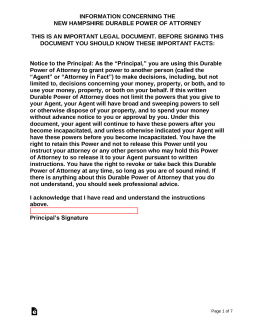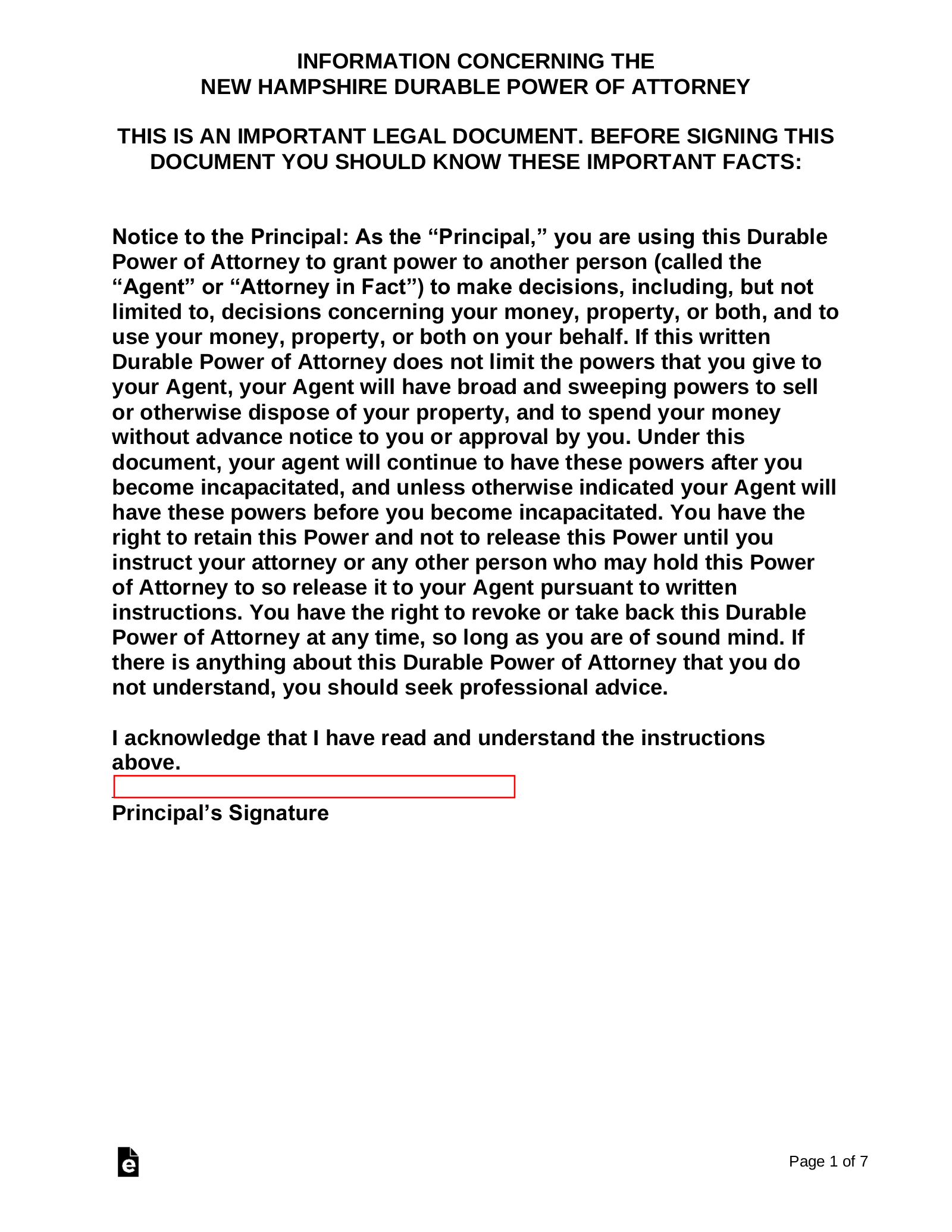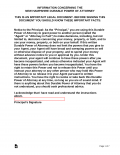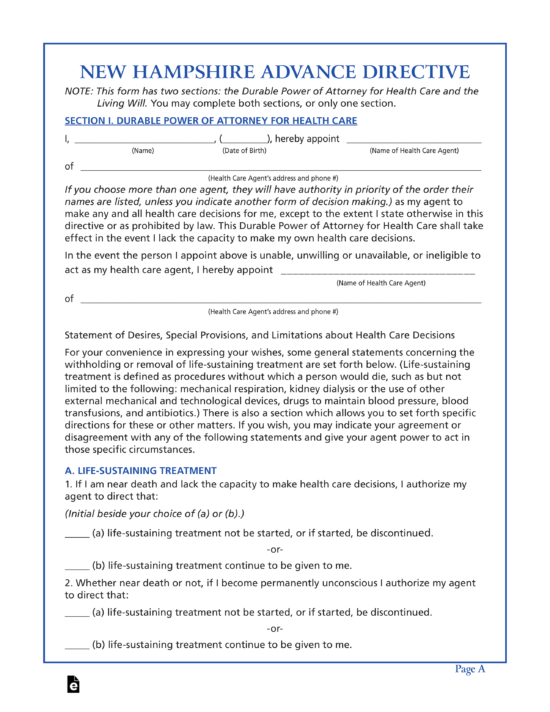Updated August 09, 2023
A New Hampshire durable statutory power of attorney form allows a person (“principal”) to transfer the handling of financial affairs to someone else (“agent”). The powers given can be limited or broad depending on the principal’s preference. The term “durable” refers to the fact that this power of attorney does not terminate if and when the principal becomes incapacitated. After signing in accordance with State law, the agent must present this form to every third (3rd) party when acting on behalf of the principal.
Versions (2)
Download: PDF, MS Word, OpenDocument
Estate and Elder Law Group Version
Download: PDF
Table of Contents |
Laws
Title LVI, Chapter 564-E (Uniform Power of Attorney Act)
Definition of “Durable”
“Durable,” with respect to a power of attorney, means not terminated by the principal’s incapacity (§ 564-E:102(4)).
Definition of “Power of Attorney”
Power of attorney” means a writing or other record that grants authority to an agent to act in the place of the principal, whether or not the term power of attorney is used (§ 564-E:102(15)).
Signing Requirements
The principal and agent are required to sign in the presence of a notary public (§ 564-E:105).
Statutory Form
The New Hampshire Legislature has made a statutory version of a power of attorney form available at § 564-E:301.
How to Write
1 – Open The Form Using This Page Then Provide The Principal With Instructions
The paperwork needed to delegate Principal Powers to an Agent can be view in the preview image then downloaded using the button under the image. Once this form has been obtained, the Principal will need to read the page titled “Information Concerning The New Hampshire Durable Power Of Attorney.” Once the Principal has completed this task, he or she must sign the blank space at the bottom of the first page.
2 – This Paperwork Must Identify The Principal And The Agent
The first statement on this form will request that four pieces of information be entered directly within it. The first two blank spaces should have the Full Name of the Principal and the Street Address where he or she lives clearly displayed. The remainder of this paragraph must have the Full Name and Complete Address of the Agent who can assume Principal Power through this document. Report the Agent’s Full Name on the third blank line and his or her Street Address on the last blank line in this paragraph.
3 – The Principal Powers Delegated To The Agent Must Be Discussed
The list of paragraph statements below the declaration will define several Decision-Making Powers and Principal Actions the Agent may take on behalf of the Principal. The sort of Decision-Making Powers and Principal Actions the Agent may use Principal Power with will depend solely on whether the Principal initials a statement defining that Power. The Principal must initial each Statement of Power that he or she wishes to include in the Principal Agent’s Power of Authority.
Turn your attention to the first paragraph statement with a blank line preceding it. Here the Principal can appoint the Agent with the Authority to deal with individuals, institutions, and any other entity using Principal Property over his or her Personal or Business Property (any kind) by simply initialing the blank space provided.
The Principal can also give the Agent Principal Authority to engage in conducting Business Transactions on behalf of the Principal when he or she initials the blank space corresponding to this paragraph.
In the third paragraph, the Principal will be able to appoint the Agent with the Principal Power to Collect any debts owed to the Principal and/or to Satisfy any payments owed by the Principal in the Name of the Principal by supplying his or her initials on the blank space provided.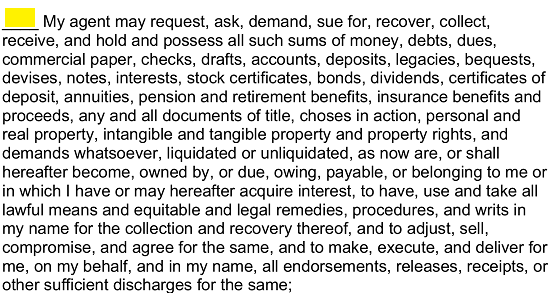
If the Agent is to engage in Leasing Property on behalf of the Principal, the fourth paragraph will provide the language to deliver Principal Power to Lease Property Out or to Lease Property on behalf of the Principal. The Principal should initial the blank space provided to grant Principal Leasing Powers to the Agent.
The fifth paragraph statement delivers the Principal Authority the Agent will need to effect Repairs and Maintenance on behalf of the Principal to the Agent once the Principal initials the blank space provided.
The Agent may be appointed with the Principal Power to Negotiate, Control, Enter, or Dissolve Contracts, Agreements, and Applications in the Name of the Principal, if the Principal initials the sixth statement.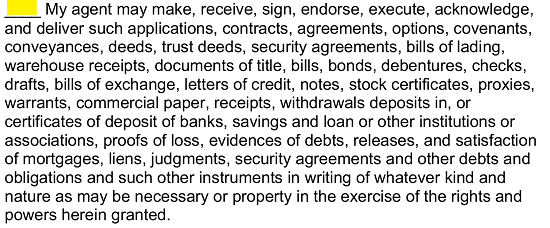
The Principal may delegate the Representational Powers needed to exert Principal Authority over his or her Taxes in relation to the I.R.S., the Treasury Department, and other interested institutions to the Agent when he or she initials the seventh paragraph. 
In the eighth statement, the Principal can appoint the Agent with the required Principal Power to perform all the actions defined here as if he or she were the Principal and to take any action necessary that such actions/directives are completed, the Principal will need to initial the blank space provided.
If the Principal Power wishes to supply additional Instructions regarding the Powers granted to the Agent in this document, he or she may do so in the last statement “Special Instructions For My Agent” using the blank lines supplied in this item. Once any such instructions have been successfully transcribed, the Principal must initial the blank line corresponding to this item.
4 – The Principal, Principal Agent, and Notary Public Must Execute This Document
In the statement beginning with the words “Dated At,” the Principal must enter the location where he or she is signing this form. Then using the second, third, and fourth line the Principal must record the Date of his or her Signature. The Principal must, then, sign the blank line directly below the words “Principal Signature” in the presence of a Notary Public.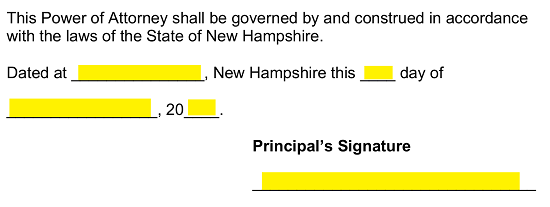
The section titled “Acknowledgment By Principal,” will be worked on by the Notary Public notarizing this signing.
Locate the page “Instructions To Agent Pursuant To N.H. Rev. Stat. Ann. §506:6” then, enter the Name of the Agent on the first blank space. After reading this passage, the Agent must provide his or her Signature on the blank space labeled “Agent’s Signature.”
The final section is the area where the Notary Public may notarize the Agent’s Signing. Only this entity may notarize the Agent’s Signature and satisfy this section’s requirements.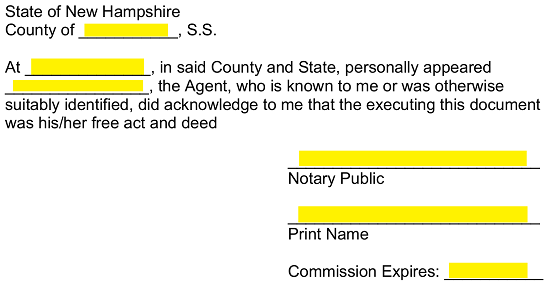
Related Forms
Download: PDF
Download: PDF

